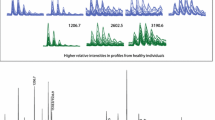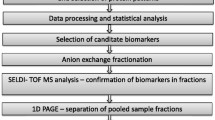Abstract
Purpose
There is no available tumor marker that can detect primary melanoma. Proteomics analysis has been proposed as a novel tool that would lead to the discovery of potential new tumor markers.
Methods
We developed a serum proteomic fingerprinting approach coupled with a classification method to determine whether proteomic profiling could discriminate between melanoma and healthy volunteers. A total of 108 serum samples from 30 early-stage [American Joint Committee on Cancer (AJCC) stage I or II] and 30 advanced-stage (AJCC stage III or IV) melanoma patients and 48 healthy volunteers were analyzed by surface-enhanced laser desorption/ionization time-of-flight mass spectrometry (SELDI-TOF-MS) utilizing protein chip technology and artificial neural networks.
Results
In a first step, a multiprotein classifier was built using a training set of 30 pathologically confirmed melanoma and 24 healthy volunteer serum samples, resulting in good classification accuracy for correct diagnosis and stage classification assignment. Subsequently, our multiprotein classifier was tested in an independent validation set of 30 melanoma and 24 non-cancer serum samples patients, maintained in a good diagnostic accuracy of 98.1% (sensitivity 96.7%, specificity 100%), and 100% stage I/II classification assignment.
Conclusions
Although results remain to be confirmed in larger collective patient cohorts, we could demonstrate the usefulness of proteomic profiling as a sensitive and specific assay to detect melanoma, including non-metastatic melanoma, from the serum.


Similar content being viewed by others
References
Balch CM, Buzaid AC, Soong SJ, Atkins MB, Cascinelli N, Coit DG, Fleming ID, Gershenwald JE, Houghton A Jr, Kirkwood JM, McMasters KM, Mihm MF, Morton DL, Reintgen DS, Ross MI, Sober A, Thompson JA, Thompson JF (2001) Final version of the American Joint Committee on cancer staging system for cutaneous melanoma. J Clin Oncol 19(16):3635–3648
Brennecke S, Deichmann M, Naeher H, Kurzen H (2005) Decline in angiogenic factors, such as interleukin-8, indicates response to chemotherapy of metastatic melanoma. Melanoma Res 15(6):515–522. doi:10.1097/00008390-200512000-00006
Caputo E, Lombardi ML, Luongo V, Moharram R, Tornatore P, Pirozzi G, Guardiola J, Martin BM (2005) Peptide profiling in epithelial tumor plasma by the emerging proteomic techniques. J Chromatogr B Analyt Technol Biomed Life Sci 819(1):59–66. doi:10.1016/j.jchromb.2005.01.022
Cazares LH, Diaz JI, Drake RR, Semmes OJ (2008) MALDI/SELDI protein profiling of serum for the identification of cancer biomarkers. Methods Mol Biol 428:125–140. doi:10.1007/978-1-59745-117-8_7
Deichmann M, Benner A, Bock M, Jackel A, Uhl K, Waldmann V, Naher H (1999) S100-Beta, melanoma-inhibiting activity, and lactate dehydrogenase discriminate progressive from nonprogressive American Joint Committee on cancer stage IV melanoma. J Clin Oncol 17(6):1891–1896
Fung ET, Wright GL Jr, Dalmasso EA (2000) Proteomic strategies for biomarker identification: progress and challenges. Curr Opin Mol Ther 2(6):643–650
Garbe C, Leiter U, Ellwanger U, Blaheta HJ, Meier F, Rassner G, Schittek B (2003) Diagnostic value and prognostic significance of protein S-100beta, melanoma-inhibitory activity, and tyrosinase/MART-1 reverse transcription-polymerase chain reaction in the follow-up of high-risk melanoma patients. Cancer 97(7):1737–1745. doi:10.1002/cncr.11250
Girosi F (1998) An equivalence between sparse approximation and support vector machines. Neural Comput 10(6):1455–1480. doi:10.1162/089976698300017269
Harpio R, Einarsson R (2004) S100 proteins as cancer biomarkers with focus on S100B in malignant melanoma. Clin Biochem 37(7):512–518. doi:10.1016/j.clinbiochem.2004.05.012
Kageshita T, Yoshii A, Kimura T, Kuriya N, Ono T, Tsujisaki M, Imai K, Ferrone S (1993) Clinical relevance of ICAM-1 expression in primary lesions and serum of patients with malignant melanoma. Cancer Res 53(20):4927–4932
Lee ML, Lu W, Whitmore GA, Beier D (2002) Models for microarray gene expression data. J Biopharm Stat 12(1):1–19. doi:10.1081/BIP-120005737
Li L, Tang H, Wu Z, Gong J, Gruidl M, Zou J, Tockman M, Clark RA (2004) Data mining techniques for cancer detection using serum proteomic profiling. Artif Intell Med 32(2):71–83. doi:10.1016/j.artmed.2004.03.006
Mian S, Ugurel S, Parkinson E, Schlenzka I, Dryden I, Lancashire L, Ball G, Creaser C, Rees R, Schadendorf D (2005) Serum proteomic fingerprinting discriminates between clinical stages and predicts disease progression in melanoma patients. J Clin Oncol 23(22):5088–5093. doi:10.1200/JCO.2005.03.164
Moller T, Anderson H, Aareleid T, Hakulinen T, Storm H, Tryggvadottir L, Corazziari I, Mugno E (2003) Cancer prevalence in Northern Europe: the EUROPREVAL study. Ann Oncol 14(6):946–957. doi:10.1093/annonc/mdg255
Petricoin EF, Ardekani AM, Hitt BA, Levine PJ, Fusaro VA, Steinberg SM, Mills GB, Simone C, Fishman DA, Kohn EC, Liotta LA (2002) Use of proteomic patterns in serum to identify ovarian cancer. Lancet 359(9306):572–577. doi:10.1016/S0140-6736(02)07746-2
Rai AJ, Stemmer PM, Zhang Z, Adam BL, Morgan WT, Caffrey RE, Podust VN, Patel M, Lim LY, Shipulina NV, Chan DW, Semmes OJ, Leung HC (2005) Analysis of human proteome organization plasma proteome project (HUPO PPP) reference specimens using surface enhanced laser desorption/ionization-time of flight (SELDI-TOF) mass spectrometry: multi-institution correlation of spectra and identification of biomarkers. Proteomics 5(13):3467–3474. doi:10.1002/pmic.200401320
Semmes OJ, Feng Z, Adam BL, Banez LL, Bigbee WL, Campos D, Cazares LH, Chan DW, Grizzle WE, Izbicka E, Kagan J, Malik G, McLerran D, Moul JW, Partin A, Prasanna P, Rosenzweig J, Sokoll LJ, Srivastava S, Thompson I, Welsh MJ, White N, Winget M, Yasui Y, Zhang Z, Zhu L (2005) Evaluation of serum protein profiling by surface-enhanced laser desorption/ionization time-of-flight mass spectrometry for the detection of prostate cancer: I. Assessment of platform reproducibility. Clin Chem 51(1):102–112. doi:10.1373/clinchem.2004.038950
Sirott MN, Bajorin DF, Wong GY, Tao Y, Chapman PB, Templeton MA, Houghton AN (1993) Prognostic factors in patients with metastatic malignant melanoma. A multivariate analysis. Cancer 72(10):3091–3098. doi:10.1002/1097-0142(19931115)72:10<3091::AID-CNCR2820721034>3.0.CO;2-V
Solassol J, Marin P, Demettre E, Rouanet P, Bockaert J, Maudelonde T, Mange A (2005) Proteomic detection of prostate-specific antigen using a serum fractionation procedure: potential implication for new low-abundance cancer biomarkers detection. Anal Biochem 338(1):26–31. doi:10.1016/j.ab.2004.11.031
Solassol J, Jacot W, Lhermitte L, Boulle N, Maudelonde T, Mange A (2006) Clinical proteomics and mass spectrometry profiling for cancer detection. Expert Rev Proteomics 3(3):311–320. doi:10.1586/14789450.3.3.311
Stahlecker J, Gauger A, Bosserhoff A, Buttner R, Ring J, Hein R (2000) MIA as a reliable tumor marker in the serum of patients with malignant melanoma. Anticancer Res 20(6D):5041–5044
Ugurel S, Rappl G, Tilgen W, Reinhold U (2001) Increased serum concentration of angiogenic factors in malignant melanoma patients correlates with tumor progression and survival. J Clin Oncol 19(2):577–583
Wakamatsu K, Kageshita T, Furue M, Hatta N, Kiyohara Y, Nakayama J, Ono T, Saida T, Takata M, Tsuchida T, Uhara H, Yamamoto A, Yamazaki N, Naito A, Ito S (2002) Evaluation of 5-S-cysteinyldopa as a marker of melanoma progression: 10 years’ experience. Melanoma Res 12(3):245–253. doi:10.1097/00008390-200206000-00008
Wilson LL, Tran L, Morton DL, Hoon DS (2004) Detection of differentially expressed proteins in early-stage melanoma patients using SELDI-TOF mass spectrometry. Ann NY Acad Sci 1022:317–322. doi:10.1196/annals.1318.047
Zhang Z, Yu Y, Xu F, Berchuck A, van Haaften-Day C, Havrilesky LJ, de Bruijn HW, van der Zee AG, Woolas RP, Jacobs IJ, Skates S, Chan DW, Bast RC Jr (2007) Combining multiple serum tumor markers improves detection of stage I epithelial ovarian cancer. Gynecol Oncol 107(3):526–531. doi:10.1016/j.ygyno.2007.08.009
Acknowledgment
We thank Pr. G. Favre and Dr. C. Allal for the use of the PBSIIc ProteinChip reader
Author information
Authors and Affiliations
Corresponding author
Additional information
J. Caron and A. Mangé contributed equally to this work.
Rights and permissions
About this article
Cite this article
Caron, J., Mangé, A., Guillot, B. et al. Highly sensitive detection of melanoma based on serum proteomic profiling. J Cancer Res Clin Oncol 135, 1257–1264 (2009). https://doi.org/10.1007/s00432-009-0567-7
Received:
Accepted:
Published:
Issue Date:
DOI: https://doi.org/10.1007/s00432-009-0567-7




